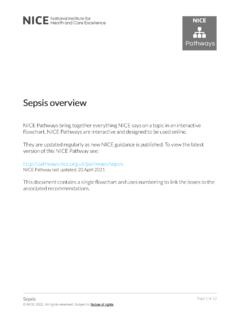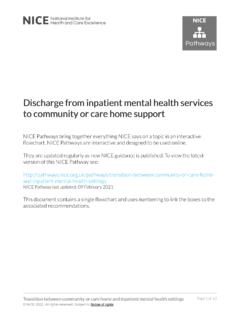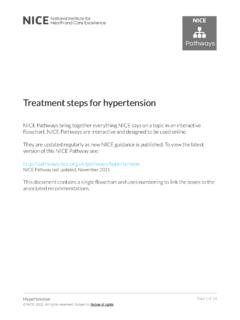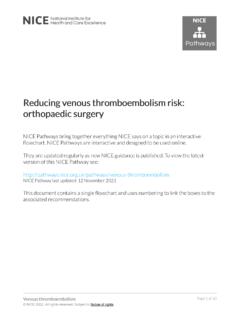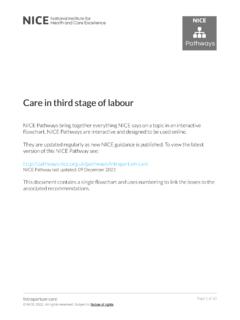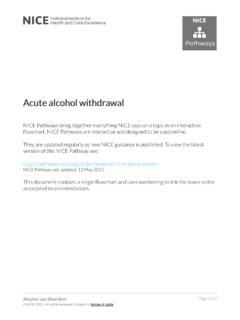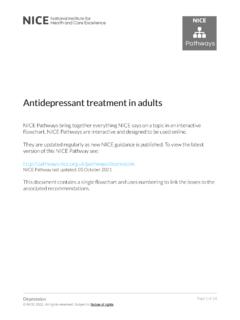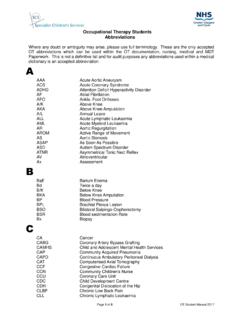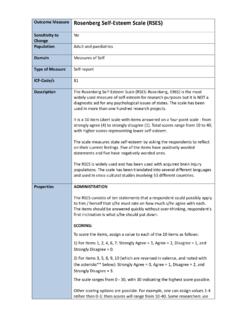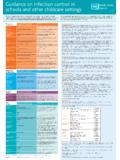Transcription of Observations of patients with head injury in hospital
1 Observations of patients with head injury in Observations of patients with head injury in hospital hospital NICE Pathways bring together everything NICE says on a topic in an interactive flowchart. NICE Pathways are interactive and designed to be used online. They are updated regularly as new NICE guidance is published. To view the latest version of this NICE Pathway see: NICE Pathway last updated: 06 December 2021 This document contains a single flowchart and uses numbering to link the boxes to the associated recommendations. Head injuryHead injury NICE 2022. All rights reserved. Subject toNotice of 1 of 8 Observations of patients with head injury in hospital Observations of patients with head injury in hospital NICE Pathways Head injuryHead injury NICE 2022.
2 All rights reserved. Subject toNotice of 2 of 81 Person with head injury admitted to hospital for observation No additional information 2 Making Observations In- hospital observation of patients with a head injury should only be conducted by professionals competent in the assessment of head injury . For patients admitted for head injury observation the minimum acceptable documented neurological Observations are: GCS; pupil size and reactivity; limb movements; respiratory rate; heart rate; blood pressure; temperature; blood oxygen saturation. See recommendations on GCS [See page 6] Perform and record Observations on a half-hourly basis until GCS equal to 15 has been achieved. The minimum frequency of Observations for patients with GCS equal to 15 should be as follows, starting after the initial assessment in the emergency department: Half-hourly for 2 hours.
3 Then 1-hourly for 4 hours. Then 2-hourly thereafter. Should the patient with GCS equal to 15 deteriorate at any time after the initial 2-hour period, Observations should revert to half-hourly and follow the original frequency schedule. Observation of infants and young children Observation of infants and young children (that is, aged under 5 years) is a difficult exercise and therefore should only be performed by units with staff experienced in the observation of infants and young children with a head injury . Infants and young children may be observed in normal paediatric observation settings, as long as staff have the appropriate experience. 3 Patient changes during observation that need review Any of the following examples of neurological deterioration should prompt urgent reappraisal by the supervising doctor.
4 Development of agitation or abnormal behaviour. Observations of patients with head injury in hospital Observations of patients with head injury in hospital NICE Pathways Head injuryHead injury NICE 2022. All rights reserved. Subject toNotice of 3 of 8A sustained (that is, for at least 30 minutes) drop of 1 point in GCS score (greater weight should be given to a drop of 1 point in the motor response score of the GCS). Any drop of 3 or more points in the eye-opening or verbal response scores of the GCS, or 2 or more points in the motor response score. Development of severe or increasing headache or persisting vomiting. New or evolving neurological symptoms or signs such as pupil inequality or asymmetry of limb or facial movement.
5 To reduce inter-observer variability and unnecessary referrals, a second member of staff competent to perform observation should confirm deterioration before involving the supervising doctor. This confirmation should be carried out immediately. Where a confirmation cannot be performed immediately (for example, no staff member available to perform the second observation) the supervising doctor should be contacted without the confirmation being performed. 4 When further imaging is needed If any of the changes noted in patient changes during observation that need review [See page 3] are confirmed, an immediate CT scan should be considered, and the patient's clinical condition re-assessed and managed appropriately. In the case of a patient who has had a normal CT scan but who has not achieved GCS equal to 15 after 24 hours' observation, a further CT scan or MRI scanning should be considered and discussed with the radiology department.
6 5 Discharge after observation patients admitted after a head injury may be discharged after resolution of all significant symptoms and signs providing they have suitable supervision arrangements at home. Do not discharge patients presenting with head injury until they have achieved GCS equal to 15, or normal consciousness in infants and young children as assessed by the paediatric version of the GCS. patients with no carer at home All patients with any degree of head injury should only be transferred to their home if it is certain that there is somebody suitable at home to supervise the patient. Discharge patients with no Observations of patients with head injury in hospital Observations of patients with head injury in hospital NICE Pathways Head injuryHead injury NICE 2022.
7 All rights reserved. Subject toNotice of 4 of 8carer at home only if suitable supervision arrangements have been organised, or when the risk of late complications is deemed negligible. 6 Discharge advice See head injury / head injury overview / Discharge advice Observations of patients with head injury in hospital Observations of patients with head injury in hospital NICE Pathways Head injuryHead injury NICE 2022. All rights reserved. Subject toNotice of 5 of 8 Glasgow Coma Score Base monitoring and exchange of information about individual patients on the three separate responses on the GCS (for example, a patient scoring 13 based on scores of 4 on eye-opening, 4 on verbal response and 5 on motor response should be communicated as E4, V4, M5).
8 If a total score is recorded or communicated, base it on a sum of 15, and to avoid confusion specify this denominator (for example, 13/15). Describe the individual components of the GCS in all communications and every note and ensure that they always accompany the total score. In the paediatric version of the GCS, include a 'grimace' alternative to the verbal score to facilitate scoring in preverbal children. In some patients (for example, patients with dementia, underlying chronic neurological disorders or learning disabilities) the pre- injury baseline GCS may be less than 15. Establish this where possible, and take it into account during assessment. Sources head injury : assessment and early management (2014 updated 2019) NICE guideline CG176 Your responsibility Guidelines The recommendations in this guideline represent the view of NICE, arrived at after careful consideration of the evidence available.
9 When exercising their judgement, professionals and practitioners are expected to take this guideline fully into account, alongside the individual needs, preferences and values of their patients or the people using their service. It is not mandatory to apply the recommendations, and the guideline does not override the responsibility to make decisions appropriate to the circumstances of the individual, in consultation with them and their families and carers or guardian. Local commissioners and providers of healthcare have a responsibility to enable the guideline Observations of patients with head injury in hospitalObservations of patients with head injury in hospitalNICE PathwaysHead injuryHead injury NICE 2022. All rights reserved.
10 Subject toNotice of 6 of 8to be applied when individual professionals and people using services wish to use it. They should do so in the context of local and national priorities for funding and developing services, and in light of their duties to have due regard to the need to eliminate unlawful discrimination, to advance equality of opportunity and to reduce health inequalities. Nothing in this guideline should be interpreted in a way that would be inconsistent with complying with those duties. Commissioners and providers have a responsibility to promote an environmentally sustainable health and care system and should assess and reduce the environmental impact of implementing NICE recommendations wherever possible. Technology appraisals The recommendations in this interactive flowchart represent the view of NICE, arrived at after careful consideration of the evidence available.

